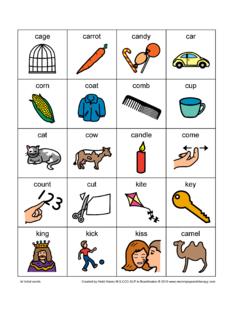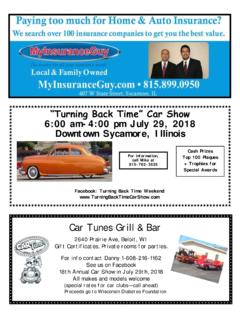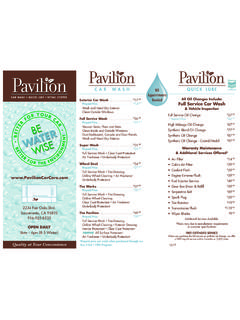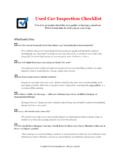Transcription of How to Build Better Scale Model Vehicles
1 How to Build BetterScale Model VehiclesConstruction Considerations for BuildingChampionship-Caliber ModelsMark S. GustavsonRobert A. WickChampionship Publishing, to Build Better Scale Model VehiclesHow to Build BetterScale Model VehiclesConstruction Considerations for BuildingChampionship-Caliber ModelsMark S. GustavsonRobert A. WickChampionship Publishing, Lake City, UtahPhotographs:Mark S. GustavsonDesign & composition:Paul Anagnostopoulos, Windfall SoftwarePrinting:Printing Express, Salt Lake CityCopyright 2001 by National Model Car Builders MuseumAlthough this booklet is copyrighted, it may be freely copied and distributed aslong as the full text and this copyright notice appears in each copy. No permissionis granted to selectively reproduce any part of this booklet, regardless of are a limited number of these booklets available in printed format.
2 You mayrequest a reasonable number of copies by sending your postal address and threefirst-class stampsfor each copyto:How to Build Better Scale Model VehiclesNational Model Car Builders Museum10271 South 1300 EastP M B # 131 Sandy, UT84094 The booklet is always available as a PDF file at the Museum and GSL Web sitesgiven visit the Web site for the National Model Car Builders Museum for the latest information about the Museum seffort to collect and preserve the history of the Scale vehicle hobby and promotethe future of the hobby. The Museum s site includes lots of photographs, researchdatabases, and other useful information for Model car hobbyists. Email messagesto the Museum may be sent from the Web also visit the GSL Championship Web site at the latest information and developments about the GSL International ModelCar Championship.
3 Email messages may be sent from the Web Publishing, , is owned byMark J. Benton S. Gustavson in the United States of machined parts shown in this booklet were made by Cody Grayland fromdrawings and specifications prepared by Mark S. Gustavson. Photoetch artworkwas created by Robert Wick and rendered by Fred Hultberg of Fotocut. Chromeplating was done by Steve The Model Realistic2 Research2 Presentation of Research Materials, Documentation,and Construction Details3 Craftsmanship5 Employ Realistic Assembly Techniques10 Components13 Building Subassemblies and Components13 Detailing19 Clean Assembly Area20 Seek the Advice of Others20 Take Your Time21 IntroductionMost modelers, at least occasionally, contemplate the construction of asophisticated, accurate, and convincing Model for display or competition not just another typical Model built at their current level of skills andabilities, but one that has that winning edge or that pushes concept,detail, and execution up to new levels.
4 When faced with the objectiveof constructing such a Model , the builder experiences the challenge ofsatisfying two very important aspects of the project: The overall scope andconcept of what the Model will look like and how complex and detailedit will be when completed; and how to design and assemble the manycomponents and integrate them with other parts to create a convincingand accurate Scale Scale automotive modeling is much more than just gluing theright handful of parts together and then assuming that a realistic andsatisfying Model will result. Rather, successful building is a mixture of theproper conceptualization of the project, systematic planning, and superbcraftsmanship in integrating a series of subassemblies and components intoone International Model Car Championship ( GSL ) judging criteriafocuses on the basic craftsmanship and realism of each Model , includingelements of authentic hydraulic/electrical/mechanical detailing, Scale thick-ness of panels, realistic and skilled use of color, paint, and other finishes, anda convincing overall appearance.
5 Too often, models displaying sophisticateddetailing and operational features do not win because they lack in areas ofbasic craftsmanship. GSL judges evaluate the sophisticated elements of anyentry only after basic craftsmanship criteria have been primarily aimed at assisting interested builders in preparing forsuccessful competition in the GSL International Model Car Championship,this modeling booklet will also be useful for all Scale vehicle miniaturistswho wish to construct thoughtful and accurate, intelligently-built scaleautomotive miniatures that create the illusion of reality. By carefully readingthe following text and checking out the photographs, and then applying thatinformation and approach to building models, you can improve the modelsyou Build and find greater success as a the Model well-defined in theme and execution?
6 The first, and crucial,step in successful Scale vehicle construction is to clarify what you want yourmodel to be. Whether you are constructing a Scale vintage hot rod, a custom,a competition vehicle , a factory dream car, a commercial vehicle , a dioramaor other subject, you need to fully consider and define the outlines of yourproject so that all of the elements of the Model are integrated with how your subject matter must look to represent the intended styleor category of vehicle , and what elements must be present to convince andinvolve viewers (and even tell a story, if appropriate).Think about what the viewer/judge will need to see to be convinced ofthe realism of your Model . If it is a period piece, do all the componentsaccurately reflect what was done or was available at the time?
7 For instance,an accurate replica of the Dick Flint roadster or the Scale reproduction of afactory stock 1950 Ford Club Coupe wouldn t have radial tires. In the caseof a weathered vehicle , it may help to create a story or history of themodel to clarify how and why it appears as it does. What about your replicaof that factory concept car why not do research into the manufacturer sdesign and marketing decisions, and then present a brief narrative of thosefacts that would aid viewers understand your project? Make sure that allelements of the models are part of a cohesive whole, and are supported byyour The Model RealisticIs the Model realistic in general appearance and detail?A convincing andcompetitive Model must be a realistic miniature of the subject.
8 For GSLcompetition, all models must be designed and built with the practicalityof use in mind. For example, there must be space in fender wells toallow wheels to turn without interference, there must be reasonable spacebetween a steering wheel and seat, and so forth. Similarly, entries in allclasses must be functional and practical for their intended use. Modelingrealism also means that operational and safety equipment should be presentand physically connected to one another. For example, GSL Factory Stockclass entries must be complete with all road-use legal equipment for the timeof their manufacture. Competition class models must have all applicablesafety equipment (roll bars, scattershields, fire extinguishers and so forth)required by the sanctioning organizations for the time frame that existedfor the vehicle modeled.
9 Custom/Street Rod/Street Machine and models ineither Commercial vehicle class must display common equipment requiredby the vehicle code (for the subject s era) for the vintage vehicle the subject well-researched and presented?Focus on your subject getfamiliar with it by doing thorough research. For example, if you have in2 How to Build Better Scale Model VehiclesFigure 1 Consult with factory documents for research on how mechanical and other systemsare to replicate in Scale a particular customized automobile, allow thetime necessary to do all possible research about that vehicle . In anothercase, if you are modeling Spencer Murray sDream Truck,for instance, besure to research and select one of the several versions that were are many sources for your research.
10 Check the catalogs frommajor book retailers. From to Classic Motorbooks, each com-pany has hundreds of titles covering virtually every aspect of the 1:1 could also check outHemmings Motor News,or one of the many deal-ers of vintage factory literature, for other more esoteric interests. Visit newcar showrooms or car shows to take photos of your Vehicles and self-service auto dismantlers to learn how 1:1 cars are assembled, andhow automotive structures are designed and fit together. Don t forget todocument that research for the judges!Presentation of Research Materials, Documentation,and Construction DetailsAre required documentation, research materials, and explanations of con-struction procedures, techniques, and details provided for the judges or theaudience?







